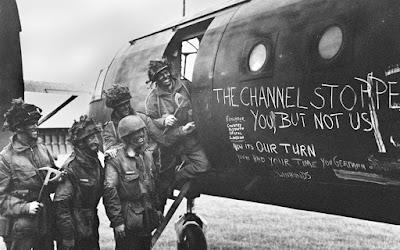Note:
A lesson that bears repeating.
When it comes to World War II, certain dates are etched indelibly into the American
consciousness, even occasionally
piercing the historical unawareness
of young people now generations removed from the
events. December 7, Pearl Harbor day
is one. August 6 when the U.S. dropped
the first Atomic Bomb making the end of the war with Japan inevitable is another.
So is June 6, known without further explanation as D-Day.
On
June 6, 1944 the Allies invaded Nazi occupied France under the overall
command of General Dwight D.
Eisenhower. It is the iconic event
of World War II in the American memory.
 |
| American troops pinned down on Omaha Beach |
Nearly
2 million soldiers, sailors, and airmen were involved in the total Operation Overlord, including those landed after the first day. 195,000
Naval personnel manned 6,039 vessels including 1,200 warships and 15 hospital ships. The United States
alone shipped 7 million tons of supplies, 14 billion pounds of material including
448,000 tons of ammunition.
 |
| British paratroopers loading for their missions to be dropped behind the German beach defenses and secure roads and bridges inland. |
Air operations in support of D-Day, which began in April,
included 14,000 missions with a loss
of 2000 air craft and 12,000 airmen
before the landing. 127 planes were lost
on D-Day alone.
On June 6th U.S. casualties
were reported as 6,603 including 1,465
dead. While these are awful numbers, there were several Civil War battles with greater dead. The Soviets
suffered more single day casualties
four or five times. And losses in some Pacific landings per men engaged were more than 5 times as high. Total allied casualties that day among
U.S. British, Canadian, Free French,
and Polish troops are estimated to
be in excess of 10,000. German losses
are less well documented but are
estimated between four and nine thousand.
 |
| A fraction of the cost--American dead at the water line on Omaha Beach |
But
heavy German resistance confined the invaders to a small zone
around the landing beaches until a breakout
began on July 25.
 |
| U.S. Army Air Force B-26 Marauder medium bombers over the invasion fleet to pound German positions. |
Once free, the Allied advance
across France was remarkably swift. Despite setbacks
like the Battle of the Bulge in
December and delays in getting a bridgehead across the Rhine into the German heartland, by the
following April British and American
units from the west met up with
Soviet troops from the east. Within a
few days of that Hitler committed
suicide, Berlin fell, and the German High Command surrendered unconditionally.
It
has been my pleasure to know several men
who either fought on D-Day or who landed on the Normandy beaches over the next few days. One of them was my late father-in-law, Art
Brady.
All of them are gone now.
Within a few years the last of the veterans of D-Day will go the way
of the ghosts of Gettysburg and Belleau Wood. The latter battle, coincidently, reached
its peak on another June 6 in 1918 when U.S. Marines suffered
their worst single day losses in history.
So much war. So much grief.

No comments:
Post a Comment